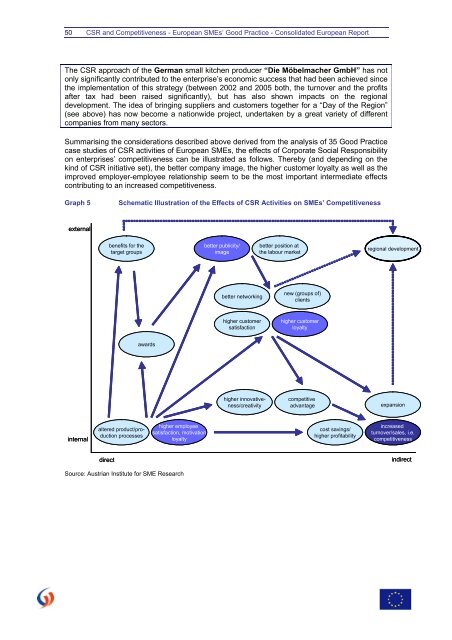CSR and Competitiveness European SMEs - KMU Forschung Austria
CSR and Competitiveness European SMEs - KMU Forschung Austria
CSR and Competitiveness European SMEs - KMU Forschung Austria
Create successful ePaper yourself
Turn your PDF publications into a flip-book with our unique Google optimized e-Paper software.
50 <strong>CSR</strong> <strong>and</strong> <strong>Competitiveness</strong> - <strong>European</strong> <strong>SMEs</strong>’ Good Practice - Consolidated <strong>European</strong> Report<br />
The <strong>CSR</strong> approach of the German small kitchen producer “Die Möbelmacher GmbH” has not<br />
only significantly contributed to the enterprise’s economic success that had been achieved since<br />
the implementation of this strategy (between 2002 <strong>and</strong> 2005 both, the turnover <strong>and</strong> the profits<br />
after tax had been raised significantly), but has also shown impacts on the regional<br />
development. The idea of bringing suppliers <strong>and</strong> customers together for a “Day of the Region”<br />
(see above) has now become a nationwide project, undertaken by a great variety of different<br />
companies from many sectors.<br />
Summarising the considerations described above derived from the analysis of 35 Good Practice<br />
case studies of <strong>CSR</strong> activities of <strong>European</strong> <strong>SMEs</strong>, the effects of Corporate Social Responsibility<br />
on enterprises’ competitiveness can be illustrated as follows. Thereby (<strong>and</strong> depending on the<br />
kind of <strong>CSR</strong> initiative set), the better company image, the higher customer loyalty as well as the<br />
improved employer-employee relationship seem to be the most important intermediate effects<br />
contributing to an increased competitiveness.<br />
Graph 5 Schematic Illustration of the Effects of <strong>CSR</strong> Activities on <strong>SMEs</strong>’ <strong>Competitiveness</strong><br />
external<br />
internal<br />
benefits for the<br />
target groups<br />
altered product/production<br />
processes<br />
awards<br />
higher employee<br />
satisfaction, motivation<br />
loyalty<br />
better publicity/<br />
image<br />
better networking<br />
higher customer<br />
satisfaction<br />
higher innovativeness/creativity<br />
better position at<br />
the labour market<br />
new (groups of)<br />
clients<br />
higher customer<br />
loyalty<br />
competitive<br />
advantage<br />
cost savings/<br />
higher profitability<br />
regional development<br />
expansion<br />
increased<br />
turnover/sales, i.e.<br />
competitiveness<br />
direct indirect<br />
Source: <strong>Austria</strong>n Institute for SME Research




